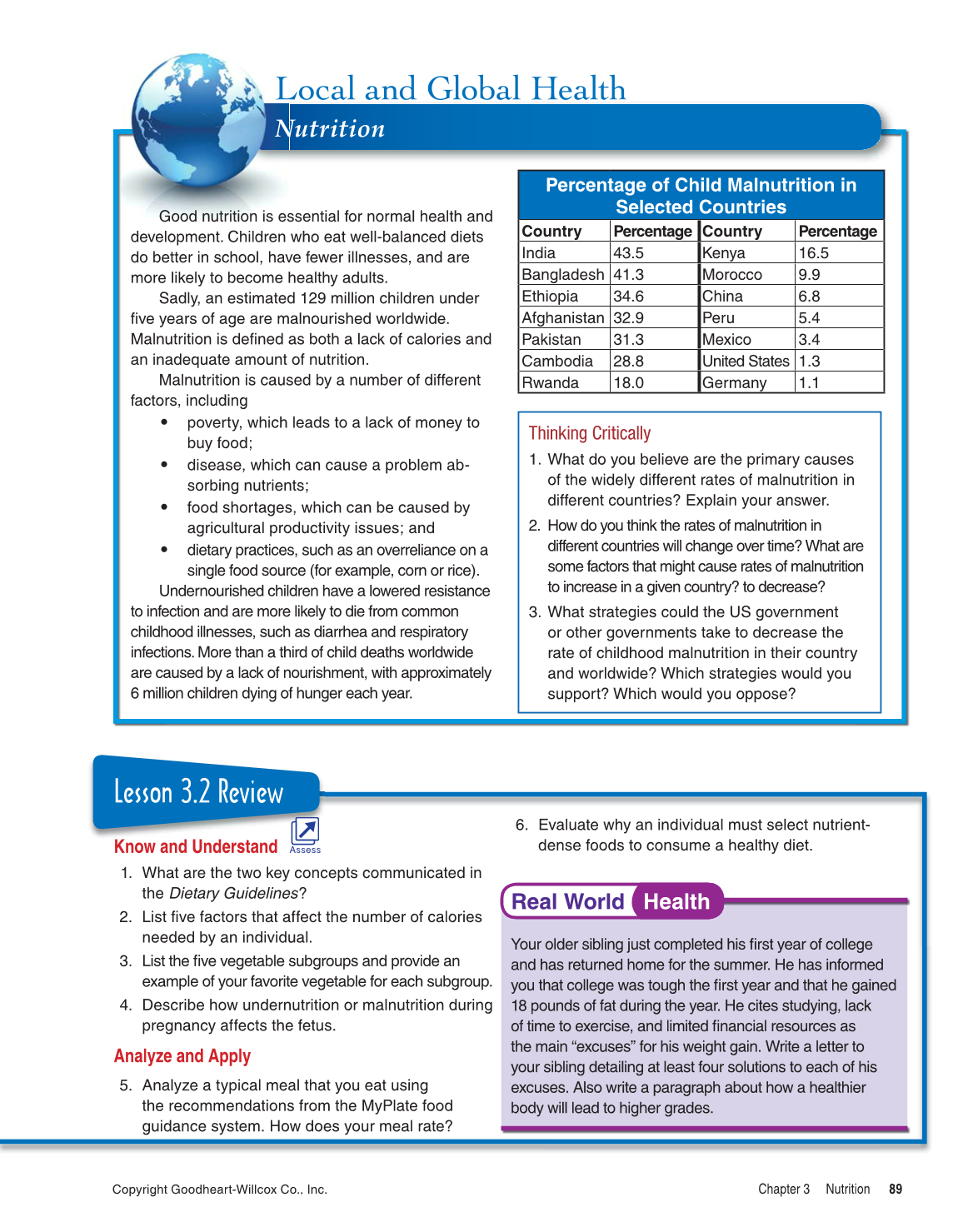Copyright Goodheart-Willcox Co., Inc.
Chapter 3 Nutrition 89
Thinking Critically
1. What do you believe are the primary causes
of the widely different rates of malnutrition in
different countries? Explain your answer.
2. How do you think the rates of malnutrition in
different countries will change over time? What are
some factors that might cause rates of malnutrition
to increase in a given country? to decrease?
3. What strategies could the US government
or other governments take to decrease the
rate of childhood malnutrition in their country
and worldwide? Which strategies would you
support? Which would you oppose?
Nutrition
Local and Global Health
N
L
Good nutrition is essential for normal health and
development. Children who eat well-balanced diets
do better in school, have fewer illnesses, and are
more likely to become healthy adults.
Sadly, an estimated 129 million children under
fi ve years of age are malnourished worldwide.
Malnutrition is defi ned as both a lack of calories and
an inadequate amount of nutrition.
Malnutrition is caused by a number of different
factors, including
•
poverty, which leads to a lack of money to
buy food;
•
disease, which can cause a problem ab-
sorbing nutrients;
•
food shortages, which can be caused by
agricultural productivity issues; and
•
dietary practices, such as an overreliance on a
single food source (for example, corn or rice).
Undernourished children have a lowered resistance
to infection and are more likely to die from common
childhood illnesses, such as diarrhea and respiratory
infections. More than a third of child deaths worldwide
are caused by a lack of nourishment, with approximately
6 million children dying of hunger each year.
Percentage of Child Malnutrition in
Selected Countries
Country Percentage Country Percentage
India 43.5 Kenya 16.5
Bangladesh 41.3 Morocco 9.9
Ethiopia 34.6 China 6.8
Afghanistan 32.9 Peru 5.4
Pakistan 31.3 Mexico 3.4
Cambodia 28.8 United States 1.3
Rwanda 18.0 Germany 1.1
Lesson 3.2 Review
Know and Understand
1. What are the two key concepts communicated in
the Dietary Guidelines?
2. List fi ve factors that affect the number of calories
needed by an individual.
3. List the fi ve vegetable subgroups and provide an
example of your favorite vegetable for each subgroup.
4. Describe how undernutrition or malnutrition during
pregnancy affects the fetus.
Analyze and Apply
5. Analyze a typical meal that you eat using
the recommendations from the MyPlate food
guidance system. How does your meal rate?
Your older sibling just completed his fi rst year of college
and has returned home for the summer. He has informed
you that college was tough the fi rst year and that he gained
18 pounds of fat during the year. He cites studying, lack
of time to exercise, and limited fi nancial resources as
the main “excuses” for his weight gain. Write a letter to
your sibling detailing at least four solutions to each of his
excuses. Also write a paragraph about how a healthier
body will lead to higher grades.
Real World Health
6. Evaluate why an individual must select nutrient-
dense foods to consume a healthy diet.
Assess
